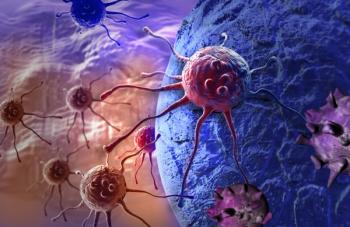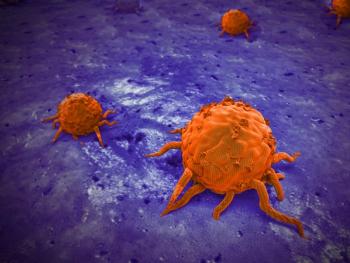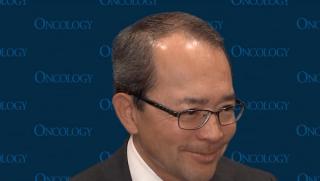
Radiation Oncology
Latest News
Latest Videos

More News

Current clinical trials look to assess 177Lu-PSMA-617 in combination with other therapies including androgen deprivation therapy and docetaxel.

An expert from Dana-Farber Cancer Institute indicates that patients with prostate cancer who have 1 risk factor should undergo salvage radiotherapy following radical prostatectomy before their prostate-specific antigen level rises above 0.25 ng/ml.

An expert from Weill Cornell Medicine highlights key clinical data indicating the benefits of radium-223 in the treatment of patients with metastatic castration-resistant prostate cancer.

The risk of radionuclide exposure to the public reflects one reason urologists need to collaborate with radiation oncologists when administering radiopharmaceuticals to patients with prostate cancer.

Switching out beta emitters for alpha emitters, including radium-223, is one way to improve radiopharmaceutical treatment of prostate cancer, according to an expert from Weill Cornell Medicine.

Data from the phase 3 ROMAN trial and the phase 2b GT-201 trial support the new drug application for avasopasem in radiotherapy-induced severe oral mucositis for those with head and neck cancer.

Patients 70 years or older with limited stage small cell lung cancer appear to tolerate concurrent thoracic chemoradiotherapy and have similar disease control rates as younger patients.

The emergence of using hypofractionated radiation treatments—fewer radiation treatments at larger doses—across cancer types may place financial strain on radiation oncologists, but one expert notes there’s still continued success.

Trial results presented at a recent medical conference demonstrated that the use of shorter duration radiation is safe and effective in prostate cancer, as well as a type of rare cancer, according to an expert.

Data presented at a recent medical conference shows that there is continued interest in observing the effects of fewer radiation treatments across several cancer types, according to an expert.

The new drug application for avasopasem for radiotherapy-induced severe oral mucositis in patients with head and neck cancer is supported by findings from the phase 3 ROMAN trial and phase 2b GT-201 trial.

Results from a pooled case control study indicate that meninges are very radiosensitive in pediatric patients who were treated at prior to age 10 years, supporting reduced dose whole brain irradiation in this population.

From shortening treatment duration without compromising efficacy in breast and prostate cancer to improving quality of life, experts share the main takeaways from the 2022 ASTRO Annual Meeting.

By analyzing CT scans with artificial intelligence, the development of pancreatic ductal adenocarcinoma may be predicted years before actual diagnosis.

A presentation from the 2022 ASTRO Multidisciplinary Head and Neck Cancers Symposium showed a de-escalated radiotherapy dose to 54 Gy vs 70 Gy led to better measures of toxicity in those with p16+ oropharyngeal squamous cell carcinoma.

In a pre-planned pooled analysis of data from the MC1273 and MC1675 trials presented at the 2022 ASTRO Multidisciplinary Head and Neck Cancers Symposium, de-escalated adjuvant radiation therapy met criteria for efficacy in human papillomavirus–related oropharyngeal squamous cell carcinoma.

Findings from the SqeDCIS trial indicated that DCISionRT was predictive of radiotherapy benefit in patients with ductal carcinoma in situ of the breast.

Patients with human papillomavirus–associated oropharyngeal squamous cell carcinoma experienced good quality of life and promising survival benefit after being treated with de-escalated adjuvant radiation therapy.

Patients with up to 5 oligometastases tolerated stereotactic body radiation therapy well, with investigators identifying a relatively safe toxicity profile of grade 2 or higher adverse effects.

Patients with human papillomavirus–associated oropharyngeal squamous cell carcinoma experienced efficacious survival benefits from treatment with primary radiotherapy.

Patients receiving trastuzumab for HER2-positive breast cancer on the phase 3 HERA trial did not have an increased risk of cardiotoxicity from radiation therapy.

Patients who were treated with extreme hypofractionation after breast conserving surgery saw no increase in ill-treatment effects compared with those receiving moderate hypofractionation.

A retrospective review found that external-beam radiation therapy has been underutilized as a bridging therapy in patients with hepatocellular carcinoma seeking transplant, although its prevalence has increased over the past decade.

Stereotactic body radiotherapy added to standard of care treatment resulted in better progression-free survival for those with oligoprogressive non–small cell lung cancer.

The use of hypofractionated image-guide radiotherapy was not found to improve overall survival for patients with non–small cell lung cancer and poor performance status versus conventional fractionated radiation techniques.























































































